RetroLisa
----------------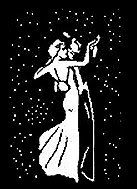 | 1930s Fashion | |
|
___________________________________________________________________________________________________________
|
|
|
RetroLisa
| _____________________________________________________ | ____________________ | __ | ______________________ | _______ | Skirts & Dresses
Fashion went from one extreme to the other in just 20 short years.
Edwardian fashions were characterized by floor-length gowns and tightly-corseted silhouettes. By the 1920s, modern young women were sporting above-the-knee hemlines and slim, boyish figures.
After the frivolity of the 1920s, fashion found a middle ground in the 1930s. During this decade, dresses were slim, modest and elegant. Hemlines moved from well below the knee in the early 1930s to just below the knee in 1939. The boyish silhouette that was popular in the 1920s was gone, and healthy feminine curves were back in style.
1930s Patterns & Images
 |
|
| 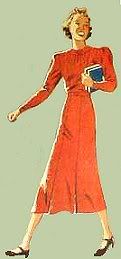 Smart styles for college students, 1936 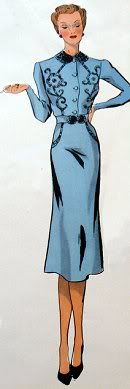
|
_________________________________________________
|
|
|
RetroLisa
| ________________________________________ | __________________________ | __ | _____________________________ | _______ | Party & Formalwear
Evening gowns were bias cut: the fabric was cut and sewed diagonally against the grain of the threads. This created garments with soft, flowing lines. Dresses that were bias cut had a tendency to cling to the body, which made a trim figure a necessity.
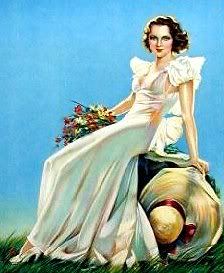 |
| |
|
_________________________________________________
|
|
|
RetroLisa
| _______________________________________ | ___________________________ | __ | _____________________________ | _______ | Outerwear & Activewear
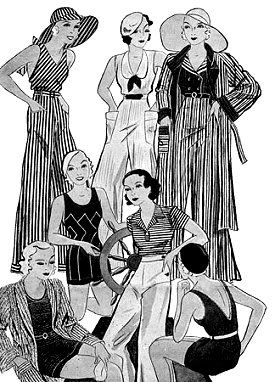
Resort wear
Traveling to warm climates during the winter was a new trend in the 1930s. This was the resort season, and naturally it required a complete line of resort wear.
Women who worked in factories during World War I were the first to wear trousers. By the 1930s, trousers for women were a standard part of any resort wardrobe. |
|
|
|
_________________________________________________
|
|
|
RetroLisa
| _____________________________________ | _____________________________ | __ | _____________________________ | _______ | Shoes & Accessories
accessories
- cloche hats
- fur stoles
- elegant wristwatches
- Empress Eugenie hats
- clutch purses
- hats with veils
foot & legwear
- stockings made of silk, chiffon & rayon
- pumps
- open-toe sandals
- shoes with buckle straps
lingerie
- silk & rayon chemises
- bras with different cup sizes
- elastic girdles with garters
- flexible elastic corsets
- silk nightgowns
After decades of torture, women were finally able to say farewell to the corset. In the 1930s, the development of a rubber-based fabric known as lastex revolutionized the shapewear industry. It was now possible for an undergarment to shape the torso without boning and lacing. New figure control garments were made of lightweight elastic and were fastened with side hooks. The corset had evolved into the girdle.
Prior to the 1930s, bust support was provided by a variety of devices. They included corsets, halters with wraparound panels, camisoles with light boning, and tight elastic bands with shoulder straps. Bras became thoroughly modern in the 1930s when they adopted a standard design that featured adjustable hooks, individual cups for separation, four different cup sizes, and underwire support.
Bras & Girdles
|
| | 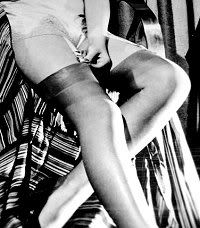 Stockings held up with garters 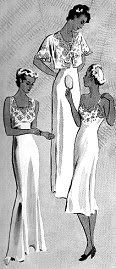
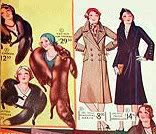
In the early 1930s, some fashions from the 1920s were still popular. They included fur stoles and close-fitting cloche hats.
Fur accessories were made of rabbit, muskrat, sable, mink, chinchilla, moleskin and silver fox pelts. When spring came, fur pieces were cleaned and put in cold storage until fall.
|
_________________________________________________
|
|
|
RetroLisa
| ______________________________________________________ | _____________________ | __ | ____________________ | _______ | Hair & Makeup
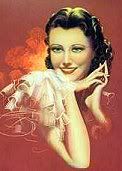
hair: cut & color
In the 1930s, short hair was definitely in vogue. This trend applied to everyone under the age of 60, regardless of facial type or personal preference. Sweet old ladies dodged the scissors and wore their hair up in a bun; everyone else sported short, perfectly coiffed hairstyles.
Early in the decade, hair was cut close to the head to resemble the bobbed and shingled styles of the 1920s. Slightly longer styles were preferred in the late 1930s.
Actresses like Jean Harlow inspired women to color their hair, although the practice was still considered scandalous by most people.
hair: curls & waves
Hair was soft and wavy and decidedly feminine. There were several waving techniques available to give your hair the distinct look of ripples on the water. Long-lasting curls were achieved with the help of a home permanent kit or a visit to the salon for a professional permanent wave.
- Wave clips were clamped onto wet hair to create rippling waves.
- A finger wave involved skillful combing of very wet hair and curling it with your fingers.
- Croquignole curls were spiral or figure-eight curls on flat rods.
- The marcel wave was invented in 1872. This popular style featured natural-looking waves that were created by flipping the curling iron upside down. In the 1930s, the term marcel was applied to all manner of wavy hairstyles and hair-waving methods.
Finger Waves
The Finger Wave
Marcel Wave
Hair Archives
1930s Authentic Coiffures
makeup
Eyebrows were plucked to a fine line and drawn in with an eyebrow pencil. Wearing makeup had become completely acceptable, and the manufacture and sale of powder, rouge and lipstick was very profitable. |
|
|
|
_________________________________________________
|
|
|
RetroLisa
| ____________________________________________________________ | __ | ____________________________________ | _______ | At The Beauty Shop
permanent waves
In the 1930s, permanent waves used chemicals and heat to produce curls. The chemicals were known as reagents, and were applied to the hair with a brush or by using special curlers and sachets saturated with chemicals and activated with water. In the 1930s, most reagents used ammonia, borax, lanoil or sulphur dioxide.
Heat was applied in one of three ways. The most common method was the electric permanent wave machine. This rather intimidating device used electricity to heat an array of metal tubes and clamps that were attached to the curlers with wires.
There were also two machineless methods in use during the 1930s. The first method simply used preheated clamps. The second method was introduced in 1931 and used chemical pads, which were wrapped around the curlers and moistened with water to generate their own heat. This was a popular choice for women who were afraid of electric perm machines.
services at the beauty shop
basic services
- haircut, shampoo & finger wave
- shingled bob style
special hairstyles
- finger waves
- croquignole curls
- marcel waves
- croquignole wave with ringlet ends
- permanent waves
other services
- Oil of Pine Needles scalp treatment
- hair tints
- henna packs
- hair dyes
- color rinse
- facial packs
- body contouring
| |
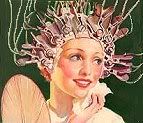

Electric permanent wave machine
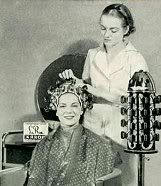
Machineless method with preheated clamps
|
_________________________________________________
|
|
|

